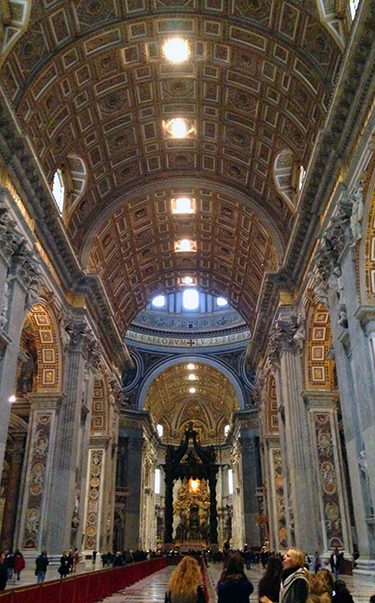Daniel McCormick ’17 – Today was one of the highlights of the trip where we get to expand our knowledge of not only Roman sculptures, but also religion by visiting the Catholic capital of the world, the Vatican City. In this post I will only discuss the Roman sculptures we looked and then another post will discuss the paintings and other highlights within the Vatican. So, lets get started!

Thanks to Professor Hartnett’s many trips to Rome he was able to secure our visit to a private museum within the Vatican Museums! We were able to closely examine several different Early Roman Empire Statues and Friezes. We started with a statue called, “The Augustus of Prima Porta.” This specific statue, according to professors Wickkiser and Hartnett, is one of the top five most famous statues from Roman Antiquity! This statue is usually on display, but was having several minor repairs done to it. That allowed us to be within mere inches from the ancient statue dating back to 15 AD. In about half an hour we were able to break down the entire statue. We reasoned that the debate regarding whether the statue was constructed before or after the death of Augustus had to be after death due to several elements of the statue.
Michael Miller presented the second thing we looked close at, the Portrait of Livia and Depictions of Empresses. He pointed out several different things include how the Julio-Claudian Era (Augustus-Nero) enlarged eyes on portraits. Michael also pointed out that angle of Livia’s face is pointed slightly down in a submissive, but empowering way like she would have been overlooking a crowd. Livia also looks to be fully clothed up to her neck, as well as, that she is wearing a cover/hood to show how reserved she is.
In another part of the Vatican Museums, Andrew Jackson presented the statue of Claudius, Emperor 37-54 AD, as Jupiter. This shows how the Emperors viewed themselves as gods, as well as, how people who earned triumphs (accomplishing great deeds, such as, winning a war) viewed themselves on theirtriumphus, day of triumph.
We concluded the tour of Roman sculptures by viewing the Sarcophaguses of Constantine’s mother and daughter, located across the room from each other and how these tombs help us answer the question, Constantine, Emperor or Christian.
Ben Farmer ’16 – As Dan described earlier, we went into the Vatican Museums to observe the artwork and statues. However, personally I preferred the tour of the old pagan/Christian tombs underneath the Vatican and the Basilica itself to the artwork.
The tour underneath the Vatican was incredibly hot and humid. The surrounding walls were all ancient rooms that were placed along the road to the north of the Circus of Gaius and Nero. There was a variation of tombs, most of them were pagan at the beginning of the tour, but as we walked down the line we started to notice a change. The closer we got to St. Peters tomb, the more Christian tombs began to pop up. The tombs themselves had a great deal of artwork and other designs that showed either pagan and/or Christian symbolism on the walls and ceilings. When we got to the tomb of St. Peter we saw his bones all locked up in little glass boxes returned to his original burial place. Along the wall of the tomb itself was a whole mess of graffiti markings. These markings, according to the tour guild, were names, symbols, prayers and other sorts of things that pilgrims had etched into the stone.
Afterwards, we went into St. Peters Basilica. This structure was massive, and beautiful. The whole building focused your attention towards the center where there was St. Peters tomb and altar. The altar itself was incredibly tall, nearly 25 meters tall at least. One of the most interesting things that I found, however, was that there was a offering table with one of the Statue of a Pope. To the right foot of the statue was a female version of Hercules standing on the club, and to the left foot stood Minerva reading a Bible and pondering it. I just thought it was interesting that they would have included that into the statue.